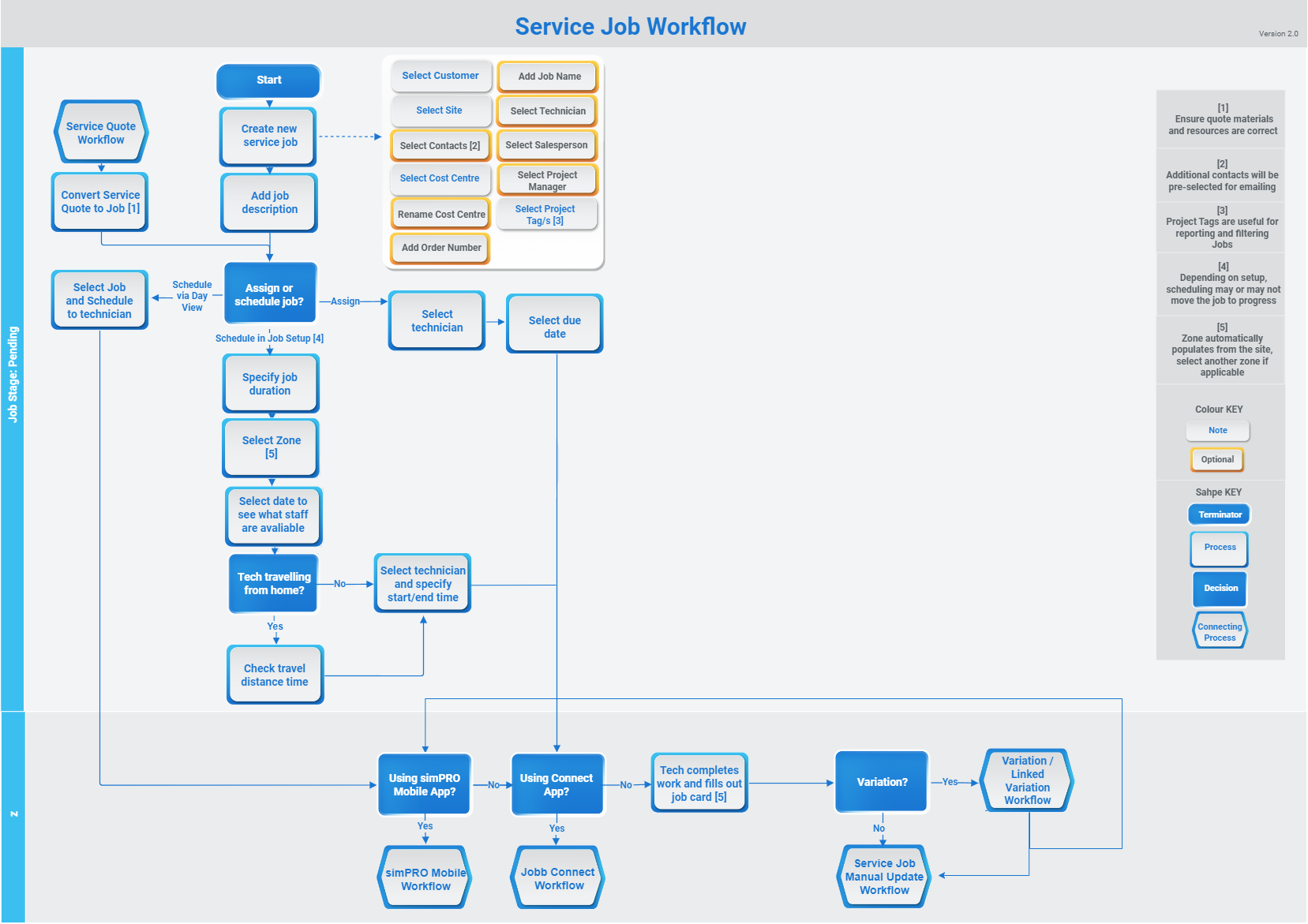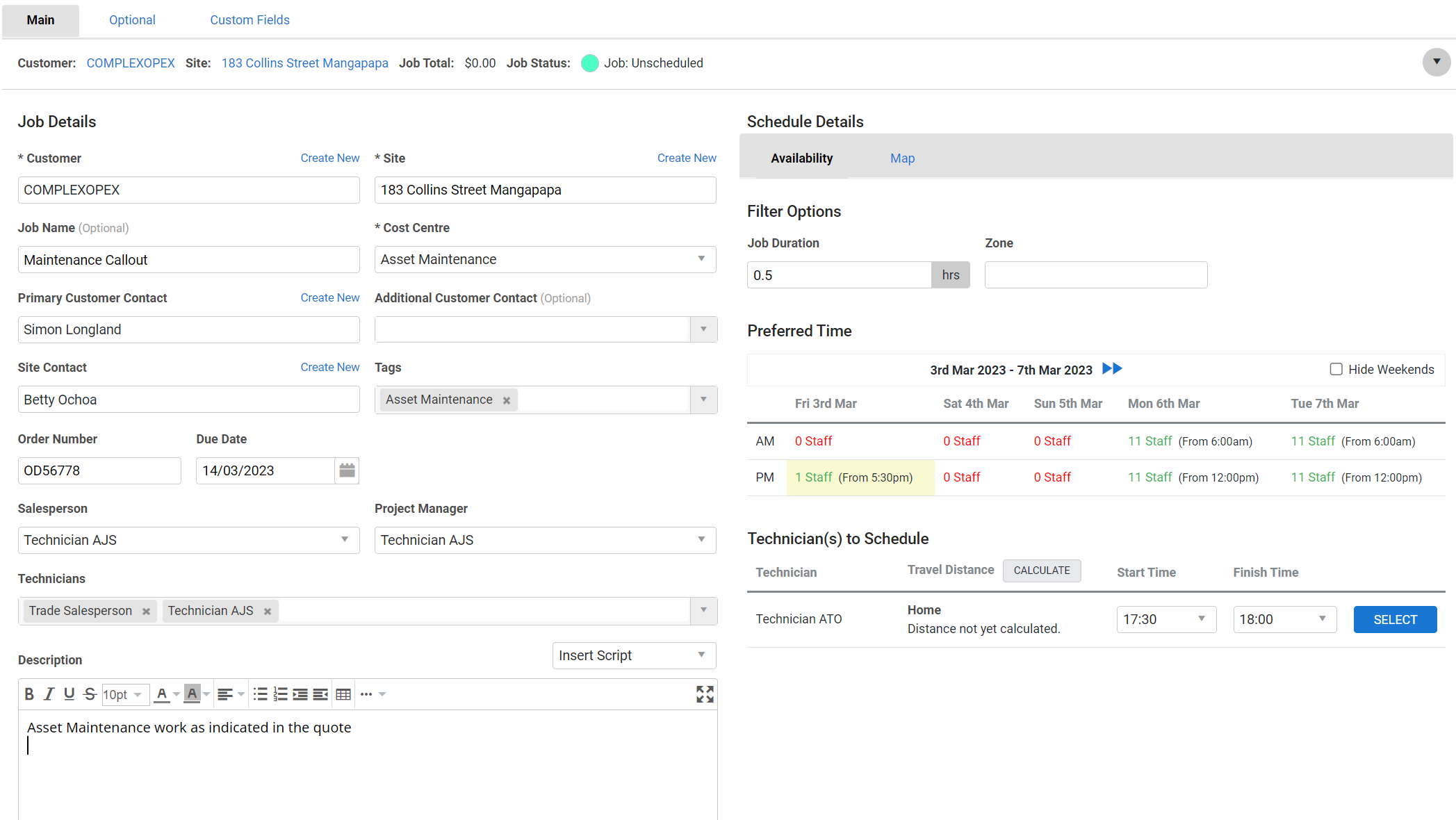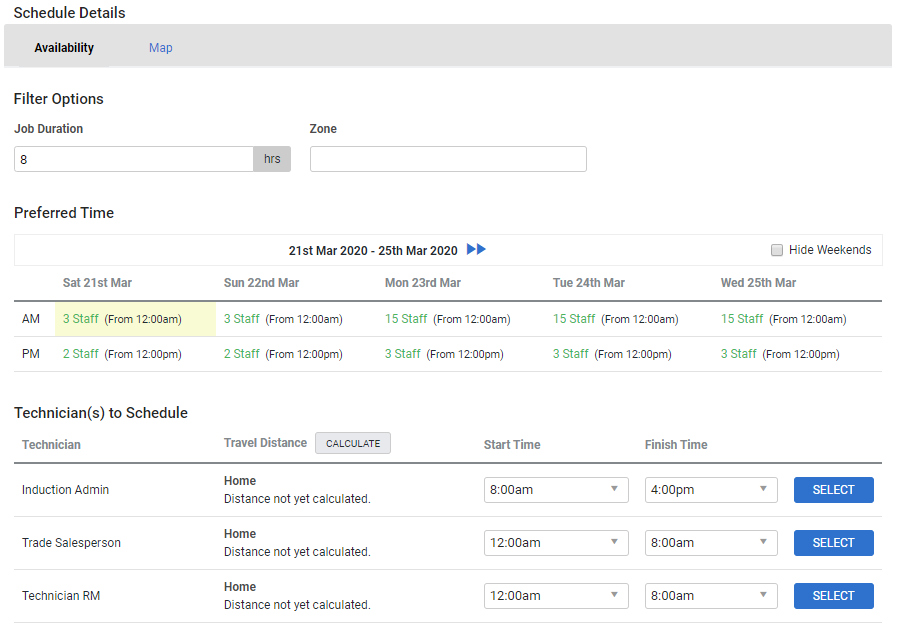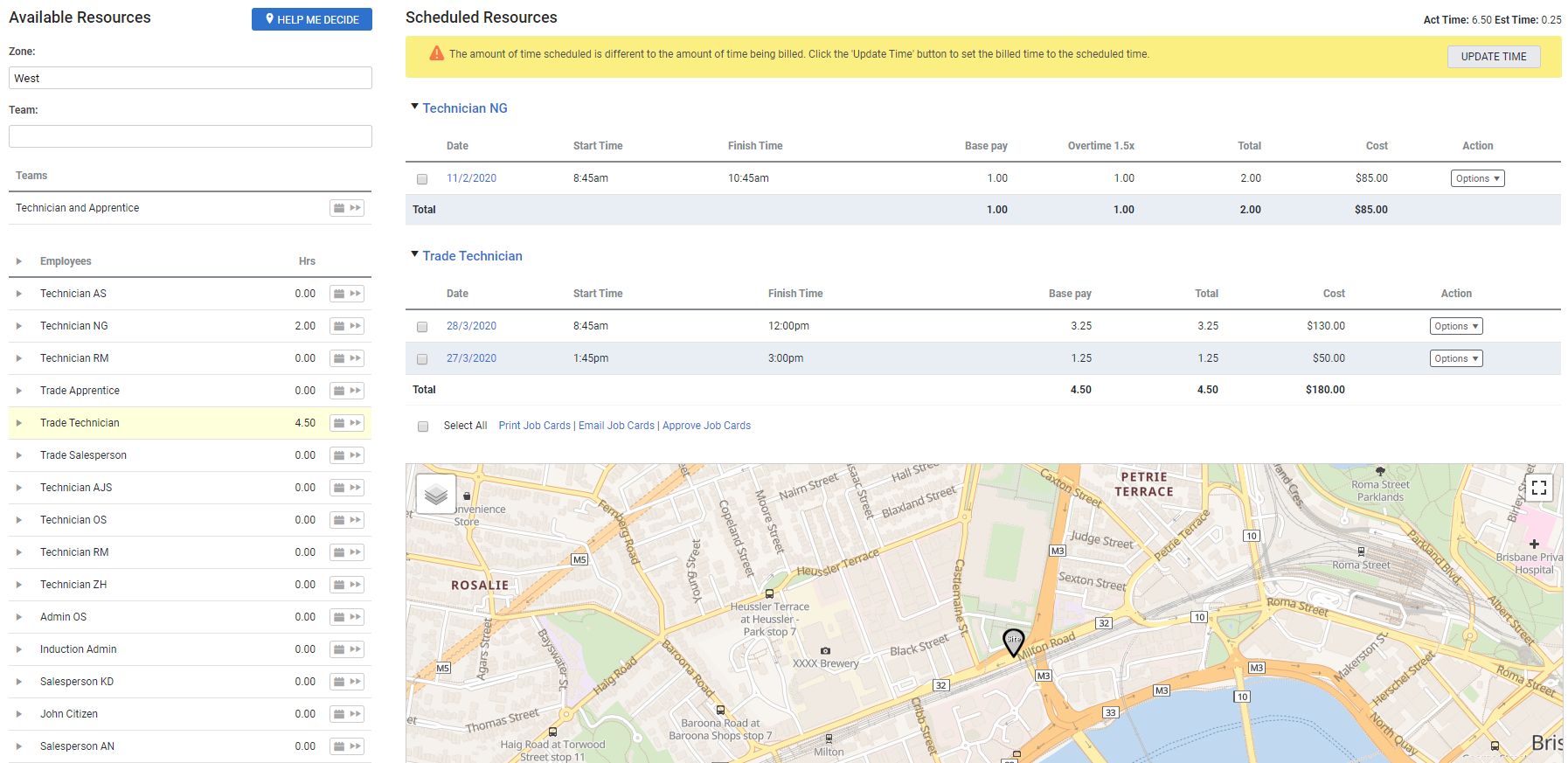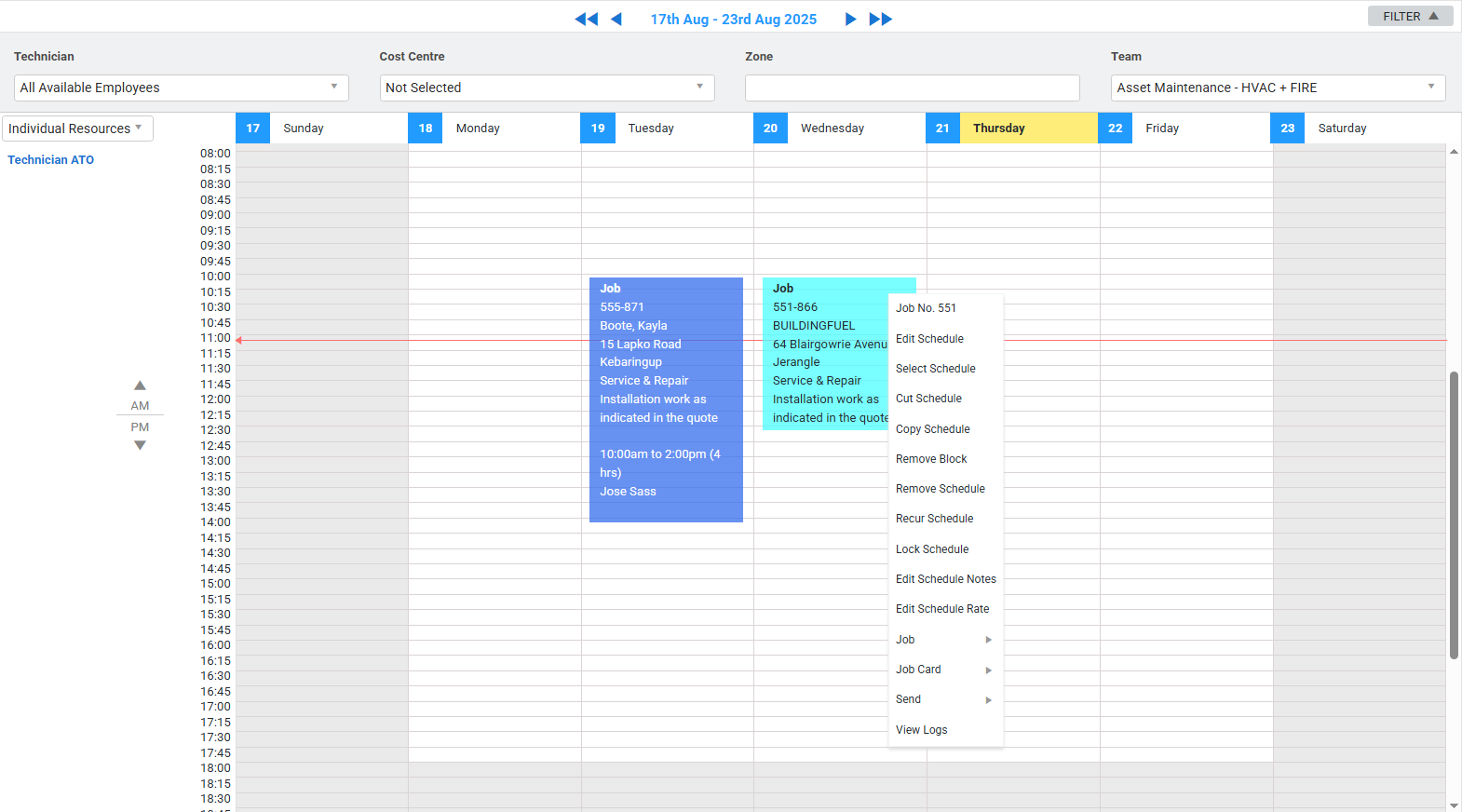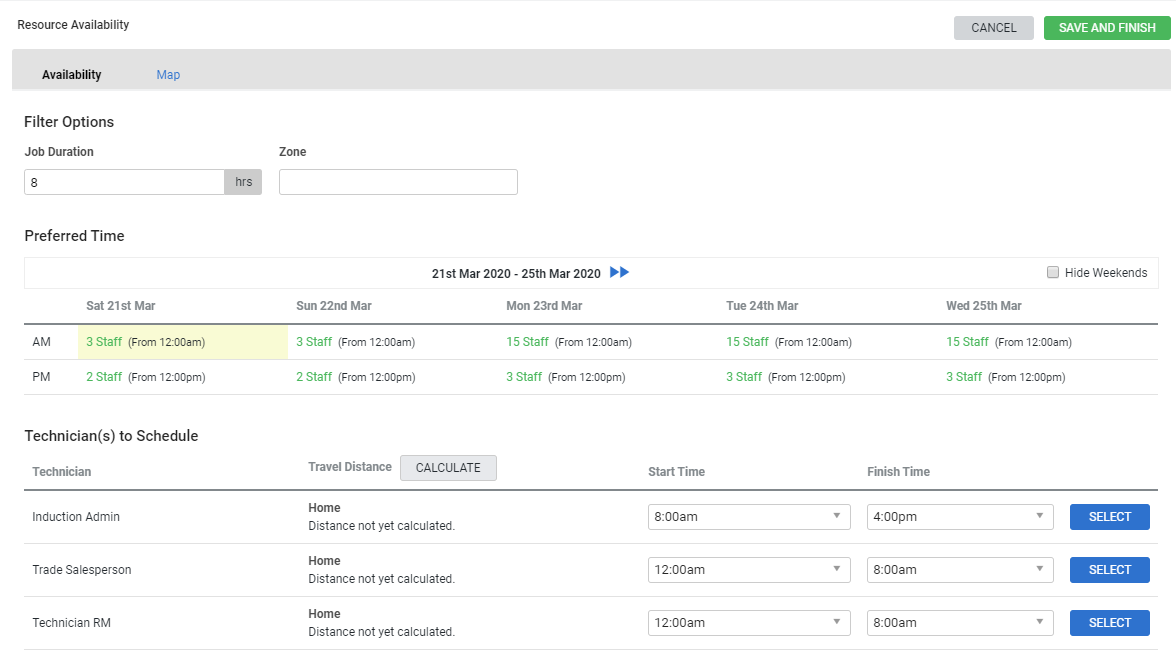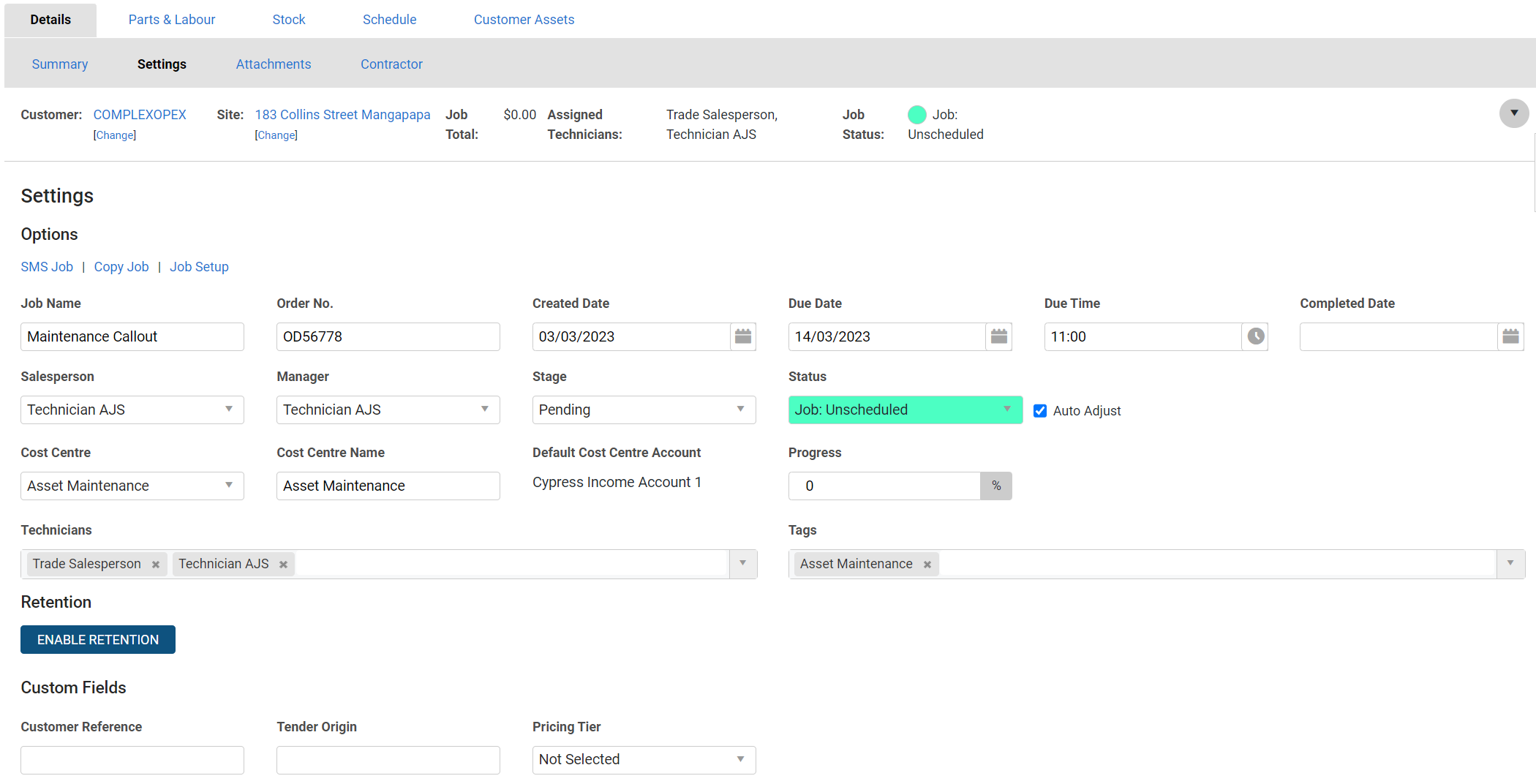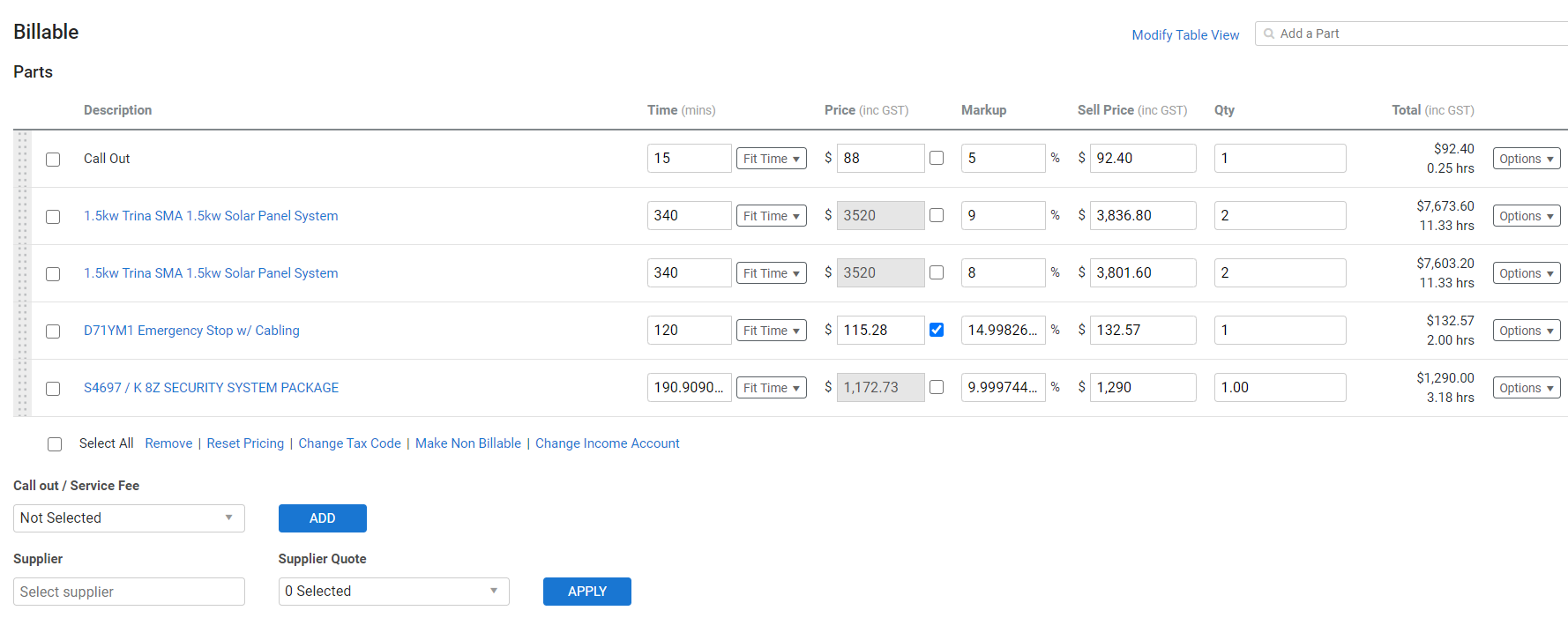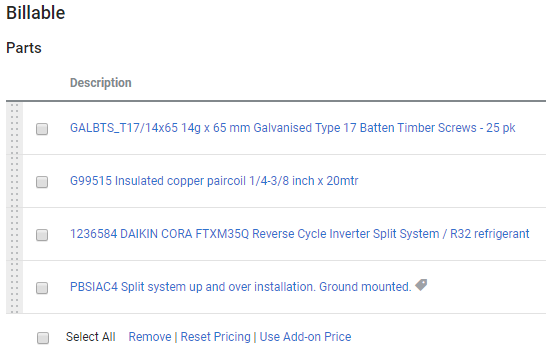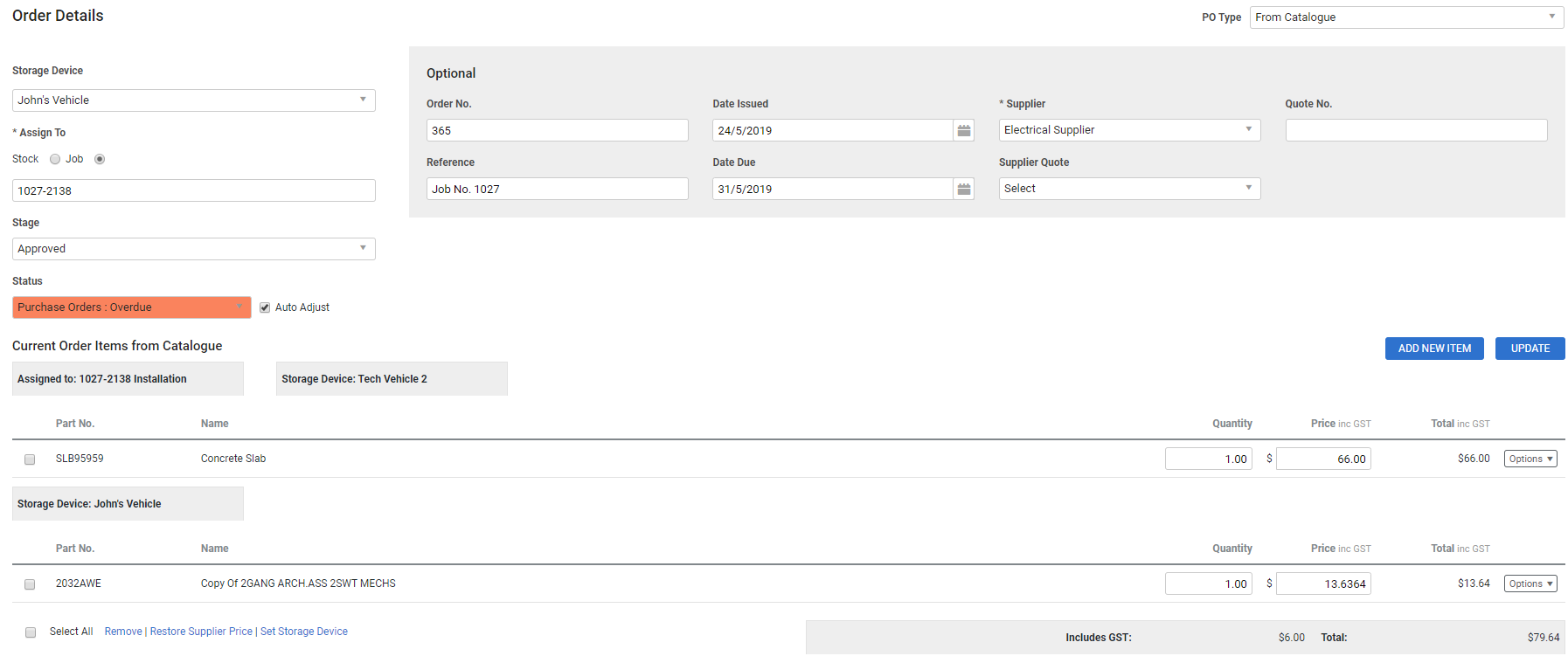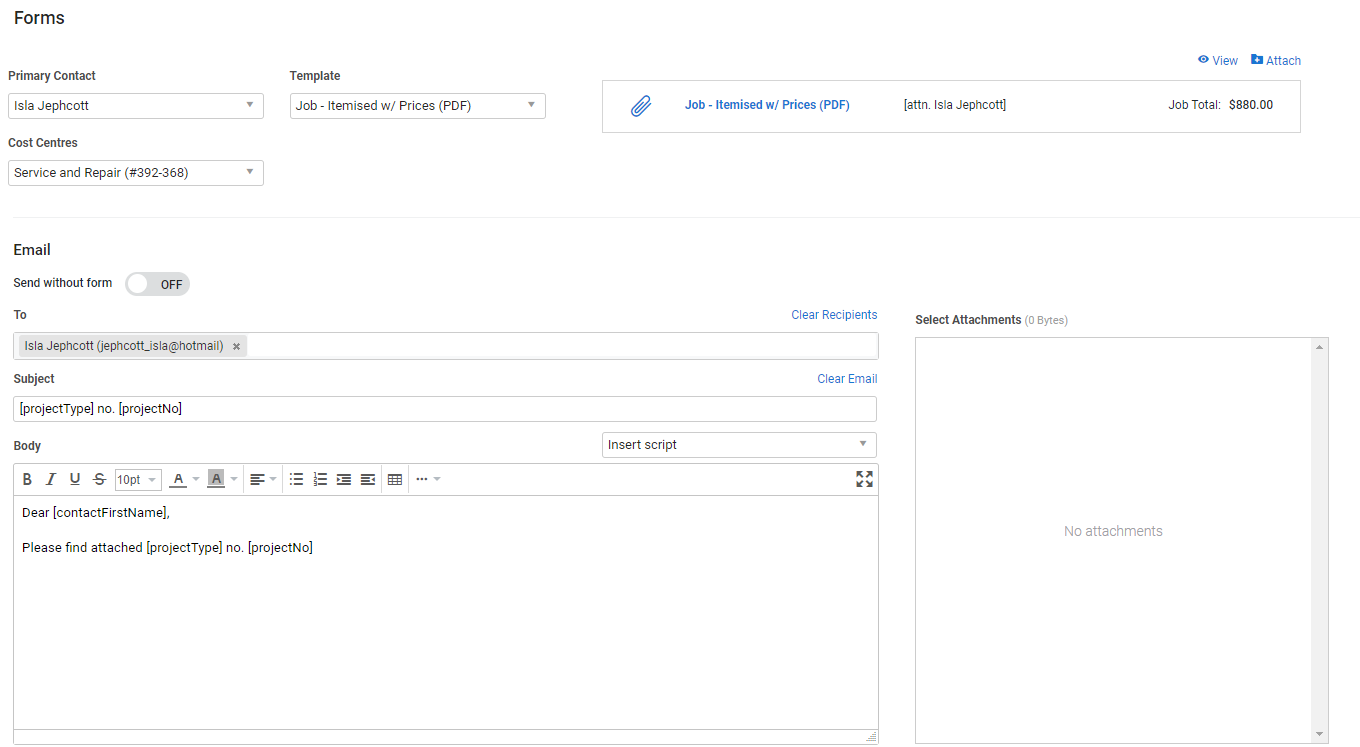Last Updated: December 15 2025
Overview
Create 'do and charge' or service jobs in Simpro Premium. When you create a service job, you can also schedule technicians, raise contractor work orders, send job forms, add labour and materials, and raise purchase orders.
You can also use memberships to automatically apply a discount to all jobs created against a customer within a specified duration, boosting customer loyalty and revenue. Learn more in About Memberships.
 Required setup
Required setup
In order to view content or perform actions referred to in this article you need to have the appropriate permissions enabled in your security group. Go to System![]() > Setup > Security Groups and access your security group to update your permissions. The relevant security group tab and specific permissions for this article can be found here:
> Setup > Security Groups and access your security group to update your permissions. The relevant security group tab and specific permissions for this article can be found here:
 Create a service job
Create a service job
You can create a service job from the Jobs menu, from the schedule Day View / Week View, or from within the customer / site card file. You can also convert a lead or quote into a job, so that all of the information already entered carries over.
To create a service job from the Jobs menu:
- Go to Jobs
 > Create New Service Job.
> Create New Service Job. - Search and select a Customer and Site from the drop-down lists.
- Alternatively, click Create New to create a new customer and / or site.
- If the customer has an active membership, it appears in the header. Learn more in How to Use Memberships in Workflows.
- Selecting an existing customer may display a warning message if the customer has invoices that are outstanding. The message indicates if the invoice is more than 30 or 90 days overdue. Click View Statement in the warning message box to open the customer statement and email it, if required. Learn more in View and email the customer statement.
- Select a Customer Contact and Site Contact, or click Create New to create new contacts.
- Click All to select contacts from all customers, sites and suppliers. Note that if you use a contact from a different customer, site or supplier, it is not linked to the site or customer used on the job.
- The contact phone numbers are then available in Simpro Mobile. The Site Contact may be a store manager, building manager etc.
- Select the Cost Centre
 US: Cost Center. A method for separating operational costs of the business for reporting and financial management..
US: Cost Center. A method for separating operational costs of the business for reporting and financial management..- Click the Optional tab to enter a new Cost Centre Name if required to provide more detail on what is involved in the cost centre.
- This name then appears in the job breadcrumbs when you click Next. See Rename a cost centre in a quote, job, recurring job, or recurring invoice for information on where else this new name appears.
- Enter an Order Number and Job Name, if required.
- Enter the job Description to appear on the job card, in Simpro Mobile, and on the customer invoice.
- Alternatively, select a script from the Insert Script drop-down list. You can then adjust the description as required using the text formatting options.
- Assign a Salesperson and / or Project Manager and enter a Due Date if required.
- You need to mark employees as Salesperson / Project Manager in their card files to select them here.
- If the employee creating the job is marked as a Salesperson / Project Manager they are automatically selected as the Salesperson / Project Manager. If not, the customer’s selected account manager is assigned as the Salesperson / Project Manager provided they are marked appropriately in their employee card files.
- Under Technicians, you can select multiple employees / contractors to assign to this job.
- If the customer has a response time assigned to their customer card, select the Response Time as required. Learn more in How to Use Response Times.
- Select Tags to categorise the job.
- Schedule a technician to the job using the options in the area to the right.
- Alternatively, you can schedule the job in the Schedule tab of the job after creating it, or go to the Schedules
 menu to schedule in a different schedule view.
menu to schedule in a different schedule view.
- You can assign a Technicians and a Due Date under the job Settings instead of scheduling to allow the technician to respond to and complete a job at their earliest convenience.
- Alternatively, you can schedule the job in the Schedule tab of the job after creating it, or go to the Schedules
- If required, Adjust default job rates and settings in the Optional tab.
- Click Save and Finish.
When you have clicked Finish on a service job, you can choose to:
| View Jobs | View all jobs in the Pending / Progress Jobs table, depending on how you have set up your automatic triggers in System |
| Edit Job | Go to the Job Summary to continue building the job. |
| Schedule Job | Schedule the job to a technician in the Day View / Week View, depending on your settings in System |
| Invoice Job | Invoice the job. |
You can return to the Job Setup page to make changes by accessing the job, then going to Details > Settings > Job Setup.
US only: If you use Simpro Premium in the United States, the term 'work order' is used instead of 'job card'.
 Adjust default job rates and settings
Adjust default job rates and settings
Click the Optional tab in the Job Setup page to adjust default material markups and / or pricing tiers, labour rates, tax codes, discounts and fees, and STC and VEEC values (only available in Australia).
If you are using Simpro Premium in the United States, this is particularly important for selecting different part and labour tax codes to apply to the entire job.
You can also remove and re-apply the customer's membership discount. Learn more in How to Use Memberships in Workflows.
 Schedule or assign a service job
Schedule or assign a service job
There are several ways to schedule service jobs to specific technicians in Simpro Premium:
- In Job Setup when you create a service job.
- In the Schedule tab of a service job.
- In the schedule Day View / Week View / Manual View.
- Assign and set a due date in the job Settings tab.
Before you begin scheduling service jobs, you may wish to use a number of Simpro Premium How to Set Up Scheduling Tools to increase scheduling accuracy and efficiency.
 Schedule a service job in Job Setup
Schedule a service job in Job Setup
To schedule a service job:
- Create a job as normal.
- In the area to the right, enter the Job Duration, then search and select the applicable Zone.
- The default Job Duration is 0.5 hours minimum. Assign a service fee to the customer to automatically populate this with additional time. Learn more in How to Set Up Service Fees.
- Under Preferred Time, click a time allotment in the AM or PM of the day.
- Select Hide Weekends or click the blue arrows to alter the schedule view as required.
- Click Calculate to filter Technician(s) to Schedule by Travel Distance to the job site.
- Enter a Start Time and / or Finish Time for the technician(s), then click Select.
- Click Save and Finish to create and exit the job or click Next to continue building the job. This creates a schedule block for each employee selected.
- If you have accessed Job Setup from Details > Settings within the job, click Update to save your changes.
 Schedule a service job from the Schedule tab
Schedule a service job from the Schedule tab
Go to Schedule in a created service job to schedule employees, contractors, and teams to the job.
To schedule a job in the Schedule tab:
- Access the job, then go to Schedule.
- Under Available Resources, click the
 icon next to the resource you wish to schedule.
icon next to the resource you wish to schedule. - In the top left of the schedule view, select the schedule rate.
- Click the time block to add a schedule block.
- Click and drag the schedule block to move it to a different day or hour.
- Click and drag the top and bottom edges to lengthen or shorten the schedule block.
- Alternatively, click + ADD to manually select the Date, Start Time and End Time of a schedule.
- You can also schedule technicians overnight when setting the Start Time and End Time. If a schedule runs overnight, a warning text will appear.
- When you have finished scheduling, click the
 icon in the top right.
icon in the top right. - Click Save and Finish > Save.
The cost displayed on the Schedule tab represents the actual direct cost of the scheduled hours. If the Schedule Rate scheduled has Overheads Included turned on, this is the sum of the employee's Pay Rate and Employment Costs with any schedule rate multipliers applied. If the schedule rate has Overheads Included turned off, this only includes the employee’s Pay Rate with any multipliers applied. Learn more in How to Create Schedule Rates.
Alternatively, click Help me decide to schedule a job using the same Filter Options as the Job Setup page.
If the quantity of hours scheduled is different to the quantity of hours being billed in Parts & Labour, or the scheduled labour rate type is different to the labour rate being billed to the customer, a warning appears. Click Update Time to match billed time to that of the scheduled hours and labour rate including time associated with service fees.
 Sort technicians by availability
Sort technicians by availability
To sort technicians by availability:
- Click Help Me Decide.
- Enter the Job Duration, then search and select the applicable Zone.
- The default Job Duration is 0.5 hours minimum. Assign a service fee to the customer to automatically populate this with additional time. Learn more in How to Set Up Service Fees.
- Under Preferred Time, click a time allotment in the AM or PM of the day.
- Select Hide Weekends or click the blue arrows to alter the schedule view as required.
- Click Calculate to filter Technician(s) to Schedule by Travel Distance to the job site.
- Enter a Start Time and / or Finish Time for the technician(s), then click Select.
- Click Save and Finish to create a schedule block for each employee selected.
 Assign a service job from the Settings tab
Assign a service job from the Settings tab
Assigning technicians allows them to complete work at their own convenience, rather than needing to complete it at a specific time. Assigned jobs appear in Simpro Mobile in the technician’s schedule on the job’s due date, without a designated time. Technicians can also search for jobs they have been assigned to in Simpro Mobile, even if the job is not due. Learn more in How to Manage Schedule in Service Module.
To assign a job to a technician:
- Open the job and go to Details > Settings.
- Under Technicians, assign one or more technicians to the job.
- Select a Due Date to have the job appear on these technicians' schedule on a specific day.
- Click Save and Finish.
 View the job summary
View the job summary
Go to Details > Summary in a service job to adjust the job description, enter private notes visible in Simpro Mobile but not visible to the customer, manage the total costs of associated parts and labour, and view a timeline of all job activity in Simpro Premium.
In the remaining Details sub-tabs, you can adjust job settings, email a job form to the customer, upload job attachments, and View the job log. You can also create job tasks and assign contractors.
Within any sub-tab, click the black drop-down arrow in the top right to view customer and site details, the job total, the assigned technician if applicable and the cost centre description.
 Adjust job settings
Adjust job settings
Go to Details > Settings in a service job to adjust the overall settings for the job and access the following options:
| SMS Job | If you have registered for and set up SMS in Simpro Premium, you can send SMS to mobile devices directly from the job. |
| Copy Job | Create an identical copy of the service job with a different job number and creation date. |
| Job Setup | Return to the Job Setup page to change the customer and / or site for the job. |
You can also enter a Job Name supplied by the customer to add additional reference information to the job, as well as an Order No. if required by the customer.
If required, adjust the date when the job was Created, as well as the Due Date / Time to receive system alerts.
The Completed Date field automatically defaults to the date the job was set to Complete and is available to edit, if required.
You can also assign a Technician to the job, as well as a Salesperson and Manager if the relevant employees have been designated in their card files.
To manually move the job to a different Stage or change the Status, select as applicable from the drop-down list. Alternatively, select Auto Adjust to change the Status using automatic triggers.
Search and select to apply project Tags to the job, select a different Cost Centre if required, and enter or update the Cost Centre Name.
You can also enter information in Custom Fields as defined in System Setup.
 Create a contractor work order
Create a contractor work order
Go to Details > Contractors in a service job to create a contractor work order. Once the contractor has completed and invoiced the job, you can record the invoice in Simpro Premium.
Alternatively, you can schedule a contractor in the Job Setup page or Schedule tab to automatically create a work order with the scheduled hours automatically applied.
Learn more in How to Manage Contractor Work Orders.
If the contractor works for an hourly rate, this should be defined in the Rates tab of the contractor card file.
US only: If you use Simpro Premium in the United States, the term 'contractor work order' is used instead of 'work order'.
 Manage parts and labour in a service job
Manage parts and labour in a service job
Go to Parts & Labour > Billable to manage all billable and non-billable parts and labour in a service job. You can Add a service fee, Add catalogue items, pre-builds and take off templates, Create and add one off items, and Manage labour in a service job.
Use the Add a Part search field in the Billable tab to quickly add items to the job. Note that this field is not visible if the cost centre is locked for items and prices.
You can use pricing from a specific supplier or supplier quote. Select the relevant catalogue items and select the Supplier Quote(s), then click Apply.
In the Parts table, you can adjust the estimated Time for an item, and you can also select a Fit Time multiplier. When adjusting Time for items, remember this affects the Estimated Time and Time Billed in the Labour table.
You can adjust the Price, Markup, Sell Price and Qty of items. To reset the Price, select the check box or click Options > Reset Pricing.
Clicking Options also allows you to open and edit an item, remove it, change the tax code or make it non-billable. You can also use the footer options to update items in bulk as non-billable and billable.
You can choose to include or exclude non-billable items in the estimated costs. Select the required items and click Exclude Costs to exclude the items, or click Include Costs to include items.
Click Modify Table View to add Discount and Sell Price (Inc discount) values on the individual line items in the Billable table.
US only: If you use Simpro Premium in the United States, the term 'vendor' is used instead of 'supplier'.
 Add a service fee
Add a service fee
In Simpro Premium, a service fee is an additional fee you charge on a job, such as a call-out fee, with or without labour included. Service fees set as a default in System ![]() > Setup > Labour > Service Fees or the customer card file are automatically added to a service job in Details > Parts & Labour > Parts.
> Setup > Labour > Service Fees or the customer card file are automatically added to a service job in Details > Parts & Labour > Parts.
To add a service fee to a service job:
- Access the job.
- Go to Parts & Labour > Billable.
- Select a Call out / Service Fee, then click Add.
- In the Parts table, adjust the Time, Markup / Sell Price and Qty of the service fee.
- Click Options to remove the fee, reset pricing, change the tax code or make the fee non-billable.
- Click Save and Finish.
Click Options > Remove Item to remove a service fee from a service job. Alternatively, select the service fee check box, then click Remove under the table.
 Add catalogue items, pre-builds and take off templates
Add catalogue items, pre-builds and take off templates
If a catalogue item record is for a large quantity of a specific material, you can update it so that it can be added to a project in smaller quantities. For example cable that is purchased from the supplier in 100m coils and sold to customers in 1 metre lengths. Learn more in How to Estimate Pack Items.
To quickly add catalogue items, pre-builds, and take off templates to your project:
- In the Parts & Labour > Billable tab, click in the Add a Part search field.
- Note that this field is not visible if the cost centre is locked for items and prices
- Filter by Catalogue items, Pre-Builds or Take Off templates. You can also add a one off item.
- Search for the required catalogue item, pre-build or take off template by part number or name.
- Click the item in the search results to add it to the Parts table.
Alternatively to add catalogue items, pre-builds, and take off templates from the different groups and subgroups:
- Access the job.
- Go to Parts & Labour > Catalogue / Pre-Builds / Take Off.
- Locate the items in the applicable Groups and / or Subgroups.
- In the Catalogue tab when you navigate to a group, click the drop-down arrow beside Create Subgroup and select Create Item to create a new item in the selected group.
- Similarly, in the Pre-Builds tab click the drop-down arrow beside the ADD ITEMS and select Create Pre-build to create a new pre-build.
- Note that if there are no items in the group or subgroup only the Create Item or Create Pre-build buttons are displayed.
- Within each group / subgroup, enter the quantity per item, then click Add Items. If you have set images to be visible on the Catalogue or Pre-Build, you can Modify table View to verify the corresponding images in the table.
- Alternatively, click Create Pre-Build / Create Item to create a new pre-build / catalogue item.
- Click Billable to Manage parts and labour in a service job as normal.
- To manage parts and labour for pre-builds click Options > Open Pre-Build > Edit > Edit Pre-Build On Job #. This only adjusts the materials in the pre-build in that job. The original pre-build is not affected.
- Click Save and Finish.
 Use add-on pricing
Use add-on pricing
If any items added in the Parts & Labour tab have add-on pricing enabled, all items use regular pricing by default. Learn more in Create a pre-build and Enable add-on pricing.
To use add-on pricing:
- In the Parts table, click Options > Use Add-on Price.
- Alternatively, select the check boxes for multiple items, then click Use Add-on Price in the footer options.
- A
 icon appears next to the item name, and the Markup and Sell Price columns update.
icon appears next to the item name, and the Markup and Sell Price columns update. - Click Save and Finish > Save.
To change the item back to regular pricing, click Options > Use Regular Price.
 Create and add one off items
Create and add one off items
Create one off items to cost non-catalogue expenses such as parking, government charges, and custom-engineered tools to a service job.
To create a one off item in a service job:
- Access the job, then go to Parts & Labour > One Off Items.
- Click Add One Off Item.
- Select the item Type.
- Select Billable to add the item to the customer invoice.
- Select Inventory Item, enter a Part No. and select a Supplier as required to be able to order and track the item as you Manage stock within a service job.
- Enter a detailed item Description.
- Enter the Estimated Cost and Markup % / Sell Price.
- If the item has associated labour, enter an Estimated Time in minutes.
- Enter Discount % for the item to show customers the discounted percentage / amount. The Sell Price (inc disc) field will be auto populated based on the Discount %.
- Alternatively, enter the Sell Price (inc disc) value to auto populate the Discount % field.
- Enter the required Quantity.
- Select a Sales Tax Code.
- Click Finish.
- Click Billable to Manage parts and labour in a service job as normal.
- Click Save and Finish.
If the actual cost of an item becomes known while a job is in progress, go to Parts & Labour > One Off Items in the job, then enter the Actual Cost and the Actual Cost Date upon which the cost was incurred.
 Manage labour in a service job
Manage labour in a service job
A labour rate that has been marked as default in the customer card file is automatically selected in the Labour table when the job is created. To add a labour rate, select as required from the Labour drop-down list, then click Add. You can then adjust the Markup, Sell Price and Time as required.
You can also adjust labour automatically to be based on hours added when you Schedule a service job from the Schedule tab. If the quantity of hours scheduled is different to the quantity of hours being billed in Parts & Labour, or the scheduled labour rate type is different to the labour rate being billed to the customer, you are prompted to update the billable labour from the Schedule tab.
Click Options on a labour rate to remove it or change the tax code if required.
You need to assign labour rates in the customer card file to add them to a job for the customer.
In the Parts & Labour tab the labour type that is selected inherits all cost and price changes made to the rate on the customer card. The cost centre must be unlocked and there must be zero hours entered for the labour rate to inherit changes. Alternatively, click the check box next to the labour type to remove the hours and force the labour rate to inherit any changes.
 Manage stock within a service job
Manage stock within a service job
Go to Stock > All in a service job to manage all required or allocated stock items. You can filter stock items according to Storage Location (storage device), or alternatively, perform a local search by entering the part number, description or search terms, then clicking Search.
In Stock > Required, you can manage required items that have not yet been ordered or allocated from stock. These are items that have been added as you Manage parts and labour in a service job.
In Stock > Allocated, manage items that have been assigned to the job. This is particularly useful for adjusting overallocation of stock.
Click the black arrows or enter quantities in the Assigned column to adjust quantities assigned to the service job. Adjusting the Assigned quantity also updates the Required quantity, provided the cost centre is not locked When you have finished making changes, click Update Materials > Save and Finish > Save. Then, go to Billable > Parts to ensure your changes have been reflected.
US only: If you use Simpro Premium in the United States, the terms 'inventory' and 'inventory count' are used instead of 'stock', 'stock take', and 'in stock'.
To view, print, email or attach a list of all stock items assigned to a service job during a selected date range, go to Details > Forms and select Picking Slip from the Template drop-down list.
 Allocate stock items
Allocate stock items
To allocate stock items to a service job:
- Access the job, then go to Stock > In Stock.
- Alternatively, access the job, then go to Parts & Labour > Stock.
- Click the appropriate storage device.
- Locate and enter quantities for the items, then click Add Items.
- Click Billable to Manage parts and labour in a service job as normal.
- Click Save and Finish.
 Raise a purchase order within a service job
Raise a purchase order within a service job
To raise a purchase order within a service job:
- Access the job, then go to Stock > Order.
- Under Purchase Type, select:
- Blank to order an item not defined in the job.
- Stock Still Required to raise a purchase order based on items in Stock > Required that have already been specified for the job from a quote.
- Purchase Order Number to raise a blank purchase order to be updated with items prior to receipting the supplier invoice.
- Select a Purchasing Stage and Purchase Currency if applicable.
- Select whether you wish to base Purchase Prices on the supplier or job.
- Click Create Purchase Order.
Once you have created a Blank or Stock Still Required purchase order, you need to select the appropriate PO Type to order items:
| From Catalogue |
Select Pre-Build components or Catalogue items. You can then return to the Order to select a different Supplier, as well as edit Quantity and Pricing. You can also click Show Cheapest Supplier / Show Cheapest Order if you have more than one supplier linked to an item. |
| From Description |
Select to enter a Description and purchase Amount for the required item(s). As quantities and stock names cannot be specified for the system, you cannot partially receipt the order. Leave the Inventory Item check box clear to ensure the order does not impact your stock levels in Simpro Premium. |
Once you have selected the PO Type, you need to select the Storage Device and Stage, enter Optional information, and enter Supplier Notes and Private Notes or select a script to specify delivery information.
When you have finished creating the purchase order, including adding or specifying the required items, click Finish > OK. Alternatively, if there are multiple suppliers on the purchase order, click a purchase order in the confirmation box to exit the job and access the purchase order.
Learn more in How to Create a Purchase Order.
US only: If you use Simpro Premium in the United States, the term 'vendor' is used instead of 'supplier'.
 Add assets to job
Add assets to job
If you are using a service job for asset maintenance you can add customer assets to the job for testing. Open a job and go to Customer Assets to create or add assets. Once the assets have been added they will appear to be tested by a technician when they complete the job in Simpro Mobile. Learn more in Add assets to jobs and How to Test Assets.
 Action job warnings
Action job warnings
As you schedule employees, assign parts and labour, receipt purchase orders and technicians use materials in the field it is possible that inconsistencies may arise in the job. Job warnings provide a way to quickly rectify these inconsistencies to ensure your jobs are accurate and balanced.
In a service job you can view warnings by opening the job and going to Details > Summary. The warnings appear above the Parts & Labour table. If a job has multiple cost centres, you can also access these warnings above the Breakdown table by opening the job, clicking on the job number in the breadcrumbs and going to Details > Summary.
The following warnings can appear and be actioned:
| The amount of materials assigned is different to the amount of materials being billed. Click ‘Update Materials’ button to set the materials billed to the materials assigned. |
This warning appears if there are fewer materials assigned from stock than the catalogue items added to be billed. Click UPDATE MATERIALS to change the quantity of billable items so that it matches the quantity assigned from stock, so that the two match. |
| The receipted price of some or all of the materials assigned is different than the cost of the materials being billed out. Click the ‘Update Price’ button to change the cost of these items to the receipted price. |
This warning appears if items have been added to this job which were ordered and receipted at a higher or lower price than the price listed on the job. Click UPDATE PRICE to automatically adjust the billable price to reflect the receipted price. |
| The amount of time scheduled is different to the amount of time being billed. Click the ‘Update Time’ button to set the billed time to the scheduled time. |
This warning appears if some time has been scheduled and the scheduled time and the amount of time on labour rates don’t match. Click the UPDATE TIME button to set the time on your labour rates to the scheduled time. |
| There are more materials used on job cards than have been able to be assigned from stock. Please check your stock levels and click ‘Assign Stock’. |
This warning appears when there aren’t enough materials in your storage devices to meet the amount added to the job by the technician completing the job card. Once you have added the required quantity of items to the storage device, click Assign Stock to add the required quantity to the job. |
 Email a job form to the customer
Email a job form to the customer
Email job forms to the customer using the standard form templates assigned in System ![]() > Setup > Forms Setup > Job > Job PDF Templates > Forms or Form Builder Templates assigned in System
> Setup > Forms Setup > Job > Job PDF Templates > Forms or Form Builder Templates assigned in System ![]() > Setup > Forms Setup > Job > Form Builder Templates. You can also select and customise a Job Detail Form to send to the customer. Learn more in How to Use the Quote / Job Detail Form.
> Setup > Forms Setup > Job > Form Builder Templates. You can also select and customise a Job Detail Form to send to the customer. Learn more in How to Use the Quote / Job Detail Form.
If you need to email job cards to your employees, you can also do this here.
To email a job form to a customer:
- Access the job, then go to Details > Forms.
- Select the (PDF) templates depending on the amount of detail you need to provide the customer.
- You can also select Form Builder job templates from the Template drop-down, and update them as required. Select a template and click View > Edit. Click Finish / Finish & Close after you make the changes.
- Alternatively, to send an email with no form, toggle on Send without form.
- If your quote / job consists of more than one cost centre and you want to only display specific cost centres on the generated form, in the Cost Centres drop-down list select the required cost centres to be displayed.
- Select All to display all the available cost centres on the form.
- Click View to preview and / or print the form.
- Select a Primary Contact to address the form to, if applicable, and click the To field to add additional contacts if required.
- Alternatively, you can manually enter email addresses and separate them with a comma.
- Any secondary contacts selected when setting up the lead / quote / job are pre-populated in the Cc field. You can also add more recipients in the Bcc field if you want to hide their email addresses from other recipients.
- Use the Cc and Bcc fields to search for employees and job contacts.
- Adjust the default Subject and Body if required. The default is set up in System
 > Setup > Forms Setup > Job > Email Setup.
> Setup > Forms Setup > Job > Email Setup.- Alternatively, click Clear Email to enter a new Subject and Body, or select a script from the Insert Script drop-down. Learn more in How to Use Scripts.
- Click Send > OK to confirm.
- If email logging is enabled for this form, a note is created in the activity timeline and in the customer card file. Learn more in Assign job form templates to appear when emailing from a job, How to Use the Activity Timeline and Create customer notes.
A pop-up may then appear confirming the email address you have just sent the form to. Click OK to return to the job, then click Attach to attach a copy of the sent form to the job for your records.
After you save the job, a log entry is created in Details > Logs, where you can view the email text and any form attachments. Learn more in View the job log.
US only: If you use Simpro Premium in the United States, the term 'work order' is used instead of 'job card'.
 View the job log
View the job log
Go to Details > Logs to view a history of actions in that job, along with the logged-in employee who performed them and the date and time.
Actions logged in the Message column of the log can include:
- Conversion from a quote
- Job creation and modifications
- Status and stage updates
- Schedule updates
- Assigning stock
- Information submitted from Simpro Mobile
- Printing and emailing forms
- Work orders created and deleted
- Accruals and deferrals created
- Invoice creation.
When you email from within the job in the Forms tab, a log entry is created with a ![]() icon. When you hover over the icon, the email text appears.
icon. When you hover over the icon, the email text appears.
When you click the icon, a pop-up containing the email text appears. If you emailed a job form, it is available to view as a PDF under Attachments.
 Advanced
Advanced
 Create a service job with multiple cost centres
Create a service job with multiple cost centres
You can create service jobs with multiple cost centres if the job requires works performed by different areas in your business. This process depends on whether you have single cost centre jobs enabled in System ![]() > Setup > Defaults > System > General > Service Jobs and Quotes.
> Setup > Defaults > System > General > Service Jobs and Quotes.
This is also useful for selling the customer a membership so they can have discount on all new quotes and jobs raised against them, as well as recurring job or invoice templates if applicable. Learn more in How to Sell Memberships.
To create a service job with multiple cost centres when you do not have single cost centre jobs enabled:
- Create the job as normal.
- Click Next.
- In Cost Centre List > Primary, select the Cost Centres from the drop-down box, enter a new Cost Centre Name if required, then click Add. Learn more in Rename a cost centre in a quote, job, recurring job, or recurring invoice.
- Once you have built your job you may wish to use the Stage, Budget Status and Name / ID filter options to narrow your selection.
- Click Save and Finish.
To create a service job with multiple cost centres when you do have single cost centre jobs enabled:
- Create a service job as normal.
- Click Next.
- Click Cost Centres in the breadcrumbs at the top of the job.
- In Cost Centre List > Primary, select the Cost Centres from the drop-down box, enter a new Cost Centre Name if required, then click Add. Learn more in Rename a cost centre in a quote, job, recurring job, or recurring invoice.
- Once you have built your job you may wish to use the Stage, Budget Status and Name / ID filter options to narrow your selection.
- Click Save and Finish.
Navigate between cost centres
There are several buttons you can use to save a job, as well as navigate between multiple cost centres added to a job.
When you access and update an individual cost centre within a job, you can click the following buttons to save and navigate between cost centres:
| Continue |
Exit the cost centre and return to the Cost Centre List. Your changes within the individual cost centre do not update to the job unless they are saved, either within the cost centre, or at the Cost Centre List level. |
| Save and Finish |
Save your changes to the individual cost centre and the entire job, and exit the job. To save your changes to the individual cost centre and the entire job, and remain in the cost centre, click the arrow and click Save. |
When you access and update a job at the Cost Centre List level, you can click the following buttons to save and navigate:
| Cancel |
Exit the job without saving. |
| Save and Finish |
Save your changes to the entire job, and exit the job. To save your changes to the entire job, and remain in the job, click the arrow and click Save. |
If you make changes to an individual cost centre, click Continue to return to the Cost Centre List, and then click Cancel, your changes will not save at all.
 Create service job tasks
Create service job tasks
Create tasks to keep an interactive to-do list for the job. Learn more in Create a task from within a quote, job, or customer card file. Then when a task is due or has been updated, the assigned technician(s) as well as any other nominated stakeholders, such as customers or employees, receive email notifications and Simpro Premium alerts.
You can also add task templates created in your System Setup to add sets of tasks frequently carried out for certain types of jobs.
The number of open tasks also appears in brackets in the Details > Tasks sub-tab. Learn more in View an open task count in a quote or job.
 Enable retention
Enable retention
Retention is the percentage of payment held by the customer to ensure the job is completed to specific standards and to safeguard against defects in workmanship.
You may wish to Set up retention for a project for a service job that you plan to merge into a project job. This is useful for calculating the amounts to be withheld to assist in invoicing.
US only: If you use Simpro Premium in the United States, the term 'retainage' is used instead of 'retention'.
 Convert a service job to a quote
Convert a service job to a quote
To create a quote from a job that was not initially quoted, you can convert a copy of the job to a quote.
To create a quote from a job:
- Access the applicable job.
- At the job level, go to Settings and click Copy Job.
- In the new job, go to the Optional tab and, under Stage, select Quote.
- Click Save and Finish.
 Walk Me Through
Walk Me Through
Need additional help?
Try Walk Me Through, our step-by-step guidance tool, to create a job.
In Simpro Premium, go to Help ![]() > Walk Me Through and search Service Job.
> Walk Me Through and search Service Job.
Learn more in How to Use Walk Me Through in Simpro Premium.
 Learn more in the Learning Toolbox
Learn more in the Learning Toolbox
For additional training, complete an interactive material in the Simpro's Learning Toolbox. Learn more in About Simpro's Learning Toolbox.
